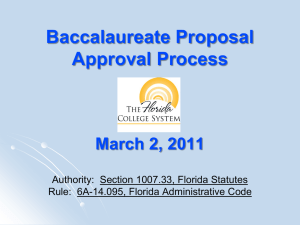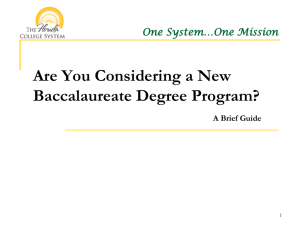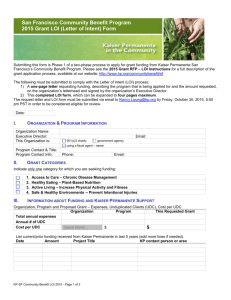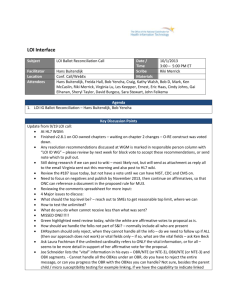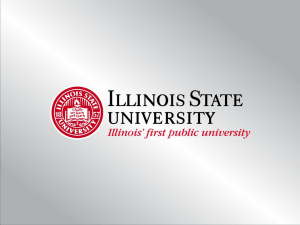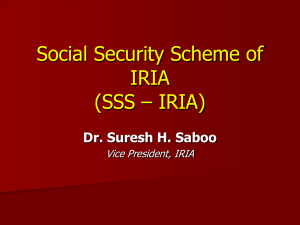Developing Baccalaureate Programs: Letter of Intent
advertisement
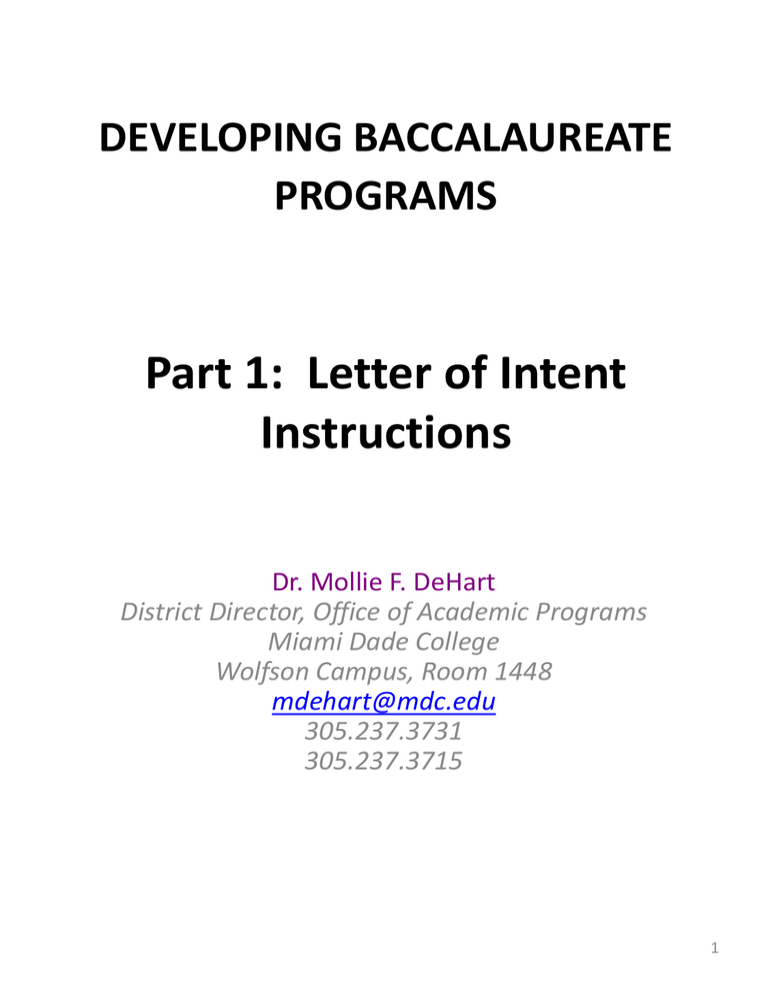
DEVELOPING BACCALAUREATE PROGRAMS Part 1: Letter of Intent Instructions Dr. Mollie F. DeHart District Director, Office of Academic Programs Miami Dade College Wolfson Campus, Room 1448 mdehart@mdc.edu 305.237.3731 305.237.3715 1 The Florida College System ■ Florida college submits Letter of Intent (LOI) to DFC 10 days □ DFC forwards the LOI within 10 days to SUS, ICUF, and CIE ● State Universities have 60 days after SUS 60 days Chancellor is notified to submit alternative proposal or objection to DFC □ If no alternative proposal is received within the 60 Developing Proposal Approval Process Florida College System (FCS) days, DFC notifies ICUF and CIE ○ Regionally Accredited private colleges and 30 days universities have 30 days to submit alternative proposal or objection to DFC □ DFC receives any SUS, ICUF, or CIE proposals but does not review 100 days after LOI ■ Florida college submits baccalaureate proposal at least 100 days after submitting LOI □ DFC receives submitted FCS proposal and conducts review 30 days □ DFC notifies the college of deficiencies in writing within 30 days following receipt of proposal ■ College corrects deficiencies and returns completed proposal to DFC □ DFC provides the completed proposal ■ Flo □ Di and accompanying materials to the Commissioner of Education ● Sta ○ Pri □ Within 45 days following DFC receipt 45 days ◊ Sta of completed proposal, the Commissioner recommends to the SBE approval or disapproval of the proposal □ DFC provides proposal, alternative proposals, objections, and related materials to SBE for consideration ◊ SBE considers the Commissioner’s recommendation, the college proposal, and any alternative proposals or objections at its next meeting ◊ If the SBE disapproves of a college’s proposal, it provides the college with written reasons ■ College must obtain Level II accreditation from SACS-COC prior to offering its first baccalaureate degree program, and provide SACS-COC with notification of subsequent changes 2 Baccalaureate Proposal Development Design Committee (http://www.mdc.edu/asa/oap/baccalaureate.aspx) Structure and Process of Proposal Development/Completion • Each Campus should establish a design committee appointed by the Campus President. • Under the direction of the Academic Dean, the Committee would be responsible for developing the proposal and Executive Summary, for understanding and working in accord with the Statewide Course Numbering System, for coordinating all surveys and business/industry data requests with Institutional Effectiveness, and for coordinating any other external outreach activities such as letters of support with the Office of the College President. • The Academic Dean would serve as the liaison with the Office of Academic Affairs in establishing deadlines, and providing personalized workshops. The following membership for the Team is suggested: • Academic Dean, Team Chair • Primary Proposal Author (Originator) • Faculty (2-3) • Campus Registrar and one or more of the following: Student Services (Director of Retention, New Student Center Director or Director of Advising) • Director, Library • Administrative Dean or Designee • Research Coordinator (possibly a Department Chair) • Department Chair familiar with baccalaureate-level faculty credentials Note: All documents must be written in “one voice” (checked for accuracy, grammar, spelling, etc.) 3 What you need to do… Prior to Letter of Intent (LOI) submission • • • Determine workforce demand and unmet need for the program – VERY important, as this information must be reviewed and approved by the Board of Trustees (BOT) and ultimately the State Board of Education to determine if program development is warranted. The LOI and complete proposal must include evidence of workforce demand and unmet need from entities independent of the institution How can you demonstrate workforce demand and unmet need? – – • Analyze local/regional/statewide employment data and statistics Reach out to the community. Contact, hold meetings with, and/or survey industry leaders, members of the business community, local chambers of commerce, regional workforce planning boards, etc. – Gauge student interest in the program (often done by survey in collaboration with Institutional Research). – An outside research consultant may be contracted to conduct a workforce need/demand analysis, if necessary. Example of LOI can be found at https://www.mdc.edu/asa/oap/faculty/baccStateSubmission.aspx; browse by the latest proposal implementation date. • Work with MDC Executive Director of Workforce Education & Partnerships , Jorge Guerra, jguerra3@mdc.edu, Ext. 7-7649. • Identify business/industry need for the program [letter(s) of support from industry, OES/AWI TOL, etc.] in collaboration with IR and Workforce Education. • Occupational Employment Statistics and Wages (OES/AWI): http://www.floridajobs.org/labor-market-information/datacenter/statistical-programs/occupational-employment-statisticsand-wages • Targeted Occupations Lists(TOL): http://tol.labormarketinfo.com/ • Bureau of Labor Statistics: http://www.bls.gov/ • O*NET OnLine: http://www.onetonline.org/ 4 What you need to do… Prior to LOI submission • Collaborate with Region 23 postsecondary (public and private) institutions – crucial! The LOI and complete proposal must include evidence that the college engaged in need, demand, and impact discussions with the regionally accredited postsecondary institutions in its service district. • How can you do this? – Initiate discussions with Region 23 State Universities, Florida Colleges, and other public and nonpublic regional postsecondary institutions regarding the need, demand, and economic impact of the program to discuss partnerships and/or the possibility of offering an on-site MDC program. – Meet in person, conduct phone calls, engage in email discussions, etc. • Upper-level administrators [Campus Presidents, Provost(s), etc.] and/or the college President would engage in these conversations. 5 What you need to do… Prior to LOI submission • Gain the approval of the BOT to proceed with submitting the LOI – Submit a description of the program (name, degree type to be conferred, career path for graduates, available facilities and resources, etc.), evidence of workforce demand and unmet need for program, summary of collaborations with Region 23 postsecondary institutions, etc. to the BOT. • Upon BOT approval, the college President submits the LOI to the Department of Florida Colleges (DFC) via the District Office of Academic Programs (OAP) • Example of LOI can be found at http://www.mdc.edu/asa/oap/baccalaureate.aspx . 6 Example of Letter of Intent Letter of Intent is produced by the Campus President & the Discipline Dean. It is then presented to the College President for Approval. 7 Example of Letter of Intent The discipline should collaborate with the Executive Director for Workforce Education & Partnerships and Institutional Research for back-up documentation. Please be advised that the Division of Florida Colleges may require additional information. 8 Resources 9 Additional Resources • • • • • • • State Application OAP Program Development Baccalaureate Proposal Development Bachelor Degree Proposal Checklist Letter of Intent (LOI) Instructions Letter of Intent (LOI) Example Baccalaureate Proposal Timeline (Developed by Dr. Susan Neimand) • MDC CASSC Meeting Schedule 10
